Johnstons of Elgin Case Study: Logistics, Supply Chain, and Efficiency
VerifiedAdded on 2023/06/09
|11
|3013
|298
Report
AI Summary
This report provides an analysis of the logistics and supply chain management strategies employed by Johnstons of Elgin, a traditional woolen factory. It examines the company's use of vertical integration, its driving efficiencies, and supply chain mechanisms. The report also discusses the implementation of upstream to downstream production processes, as well as agile and lean logistics strategies in relation to the company's operations. The analysis covers the challenges faced by Johnstons of Elgin due to globalization and increased competition, and the strategies they adopted to maintain profitability and brand image in the face of those challenges.
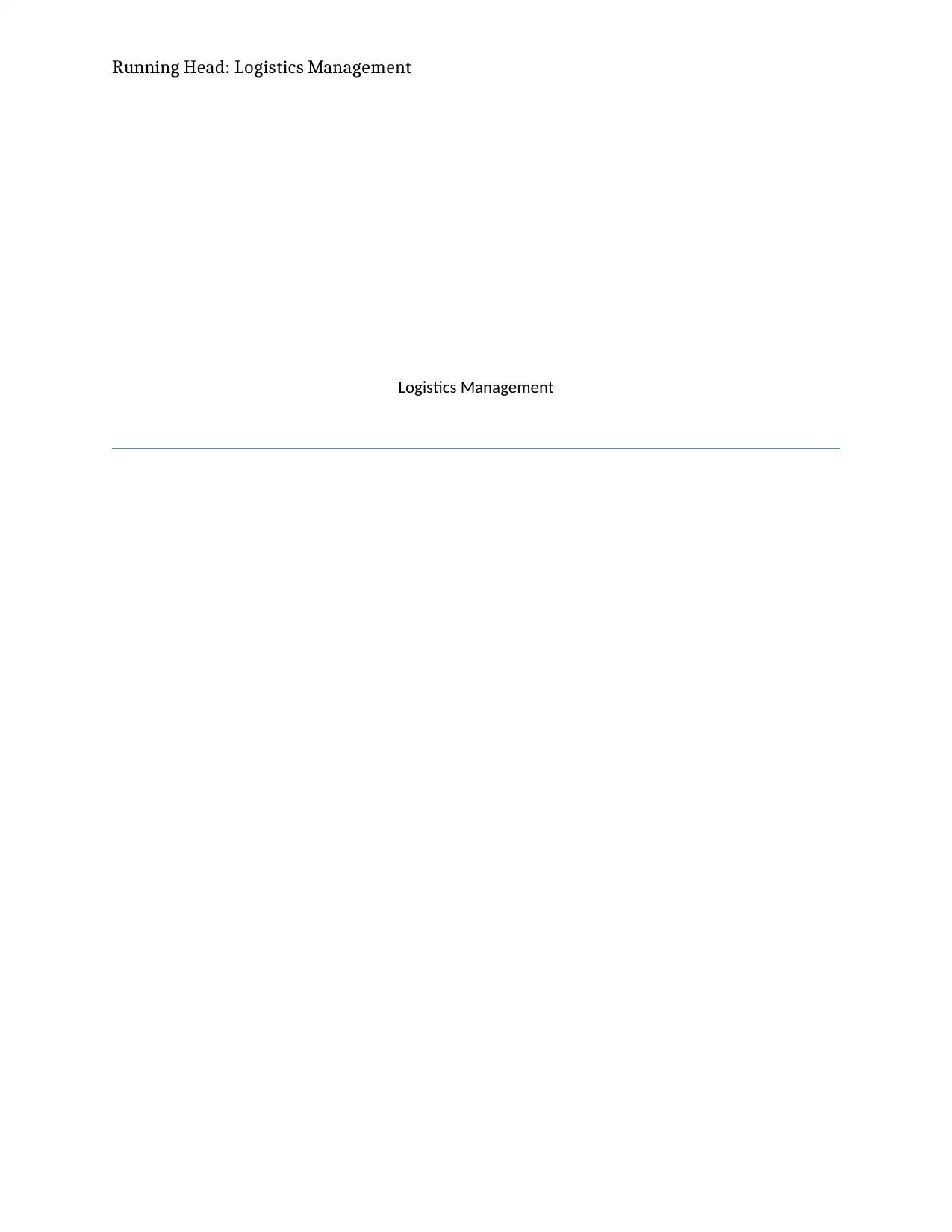
Running Head: Logistics Management
Logistics Management
Logistics Management
Paraphrase This Document
Need a fresh take? Get an instant paraphrase of this document with our AI Paraphraser
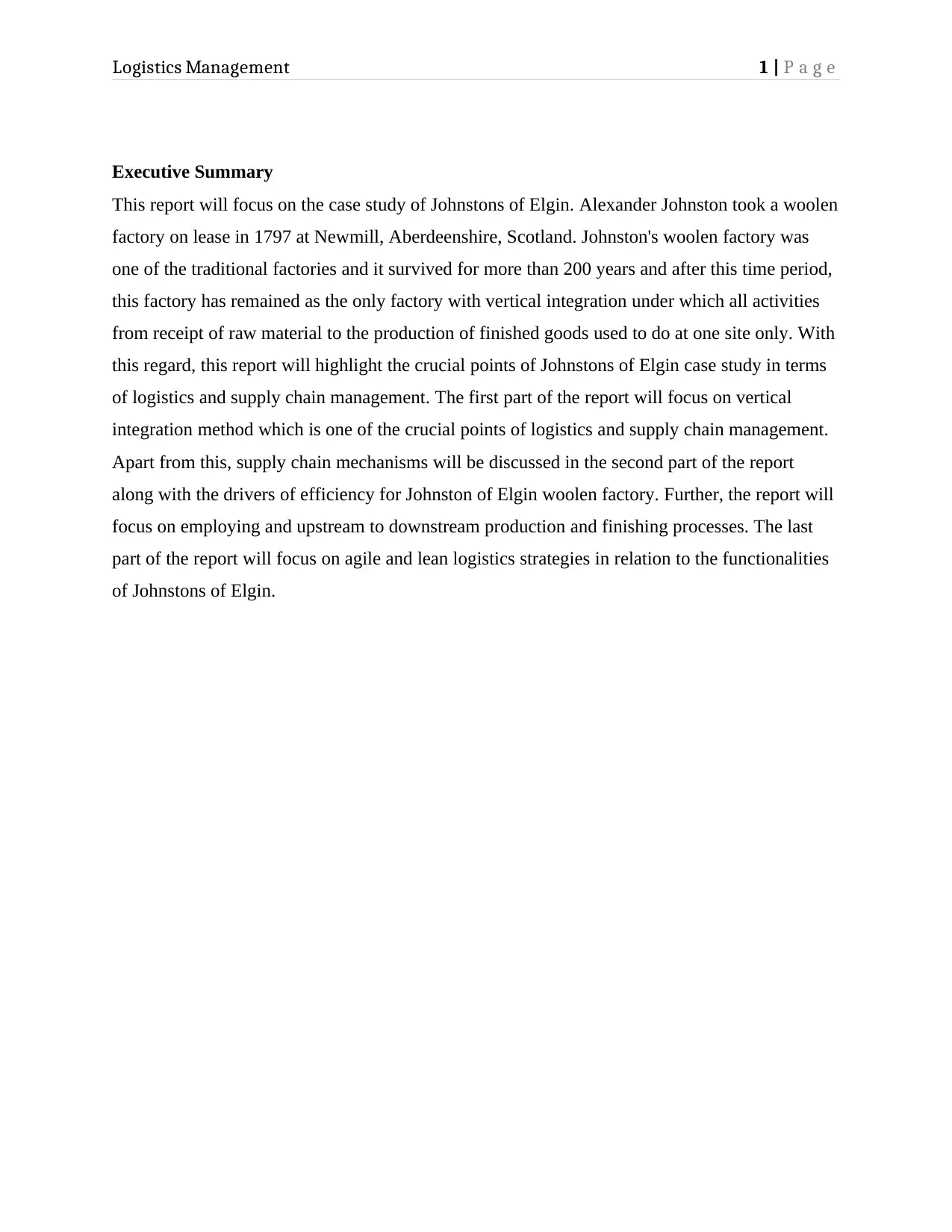
Logistics Management 1 | P a g e
Executive Summary
This report will focus on the case study of Johnstons of Elgin. Alexander Johnston took a woolen
factory on lease in 1797 at Newmill, Aberdeenshire, Scotland. Johnston's woolen factory was
one of the traditional factories and it survived for more than 200 years and after this time period,
this factory has remained as the only factory with vertical integration under which all activities
from receipt of raw material to the production of finished goods used to do at one site only. With
this regard, this report will highlight the crucial points of Johnstons of Elgin case study in terms
of logistics and supply chain management. The first part of the report will focus on vertical
integration method which is one of the crucial points of logistics and supply chain management.
Apart from this, supply chain mechanisms will be discussed in the second part of the report
along with the drivers of efficiency for Johnston of Elgin woolen factory. Further, the report will
focus on employing and upstream to downstream production and finishing processes. The last
part of the report will focus on agile and lean logistics strategies in relation to the functionalities
of Johnstons of Elgin.
Executive Summary
This report will focus on the case study of Johnstons of Elgin. Alexander Johnston took a woolen
factory on lease in 1797 at Newmill, Aberdeenshire, Scotland. Johnston's woolen factory was
one of the traditional factories and it survived for more than 200 years and after this time period,
this factory has remained as the only factory with vertical integration under which all activities
from receipt of raw material to the production of finished goods used to do at one site only. With
this regard, this report will highlight the crucial points of Johnstons of Elgin case study in terms
of logistics and supply chain management. The first part of the report will focus on vertical
integration method which is one of the crucial points of logistics and supply chain management.
Apart from this, supply chain mechanisms will be discussed in the second part of the report
along with the drivers of efficiency for Johnston of Elgin woolen factory. Further, the report will
focus on employing and upstream to downstream production and finishing processes. The last
part of the report will focus on agile and lean logistics strategies in relation to the functionalities
of Johnstons of Elgin.
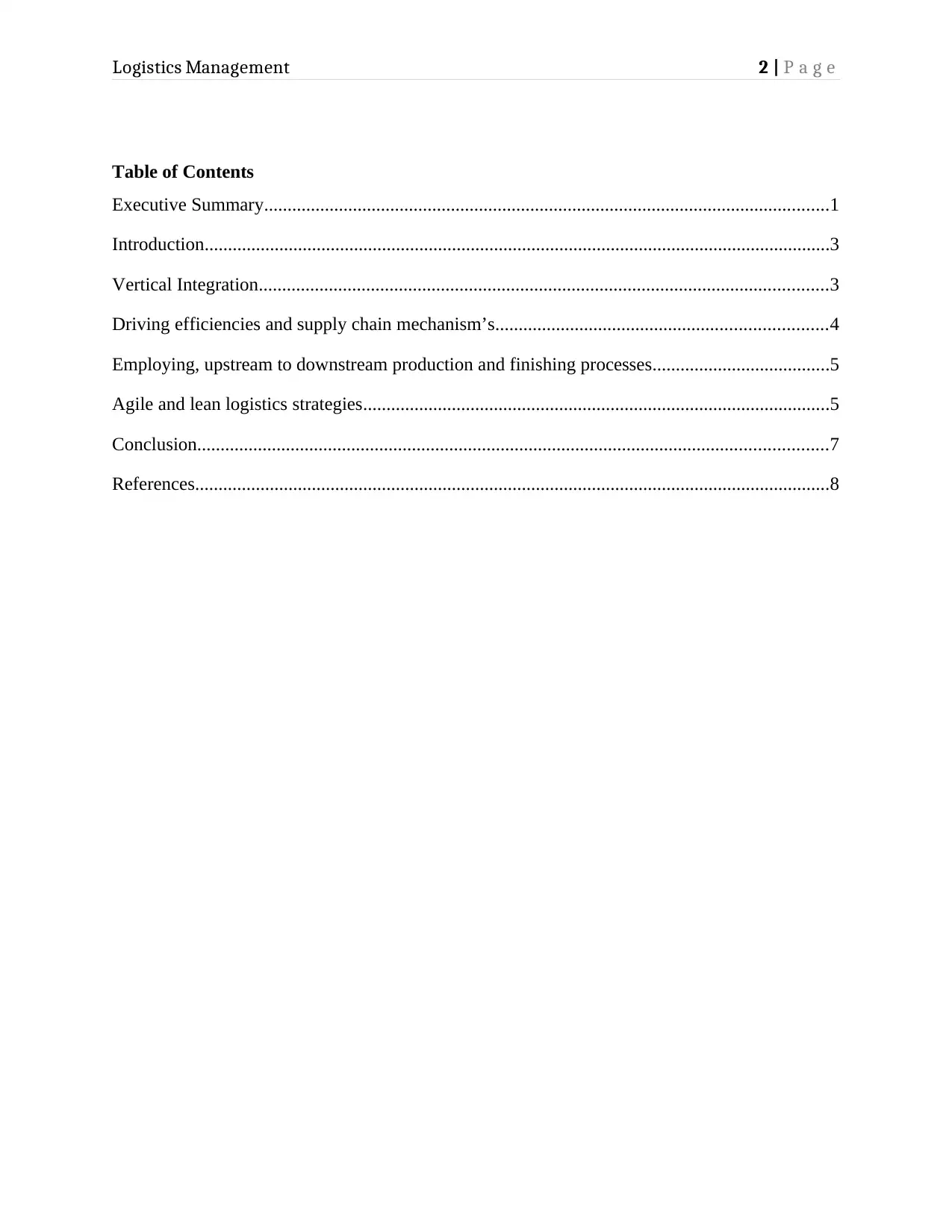
Logistics Management 2 | P a g e
Table of Contents
Executive Summary.........................................................................................................................1
Introduction......................................................................................................................................3
Vertical Integration..........................................................................................................................3
Driving efficiencies and supply chain mechanism’s.......................................................................4
Employing, upstream to downstream production and finishing processes......................................5
Agile and lean logistics strategies....................................................................................................5
Conclusion.......................................................................................................................................7
References........................................................................................................................................8
Table of Contents
Executive Summary.........................................................................................................................1
Introduction......................................................................................................................................3
Vertical Integration..........................................................................................................................3
Driving efficiencies and supply chain mechanism’s.......................................................................4
Employing, upstream to downstream production and finishing processes......................................5
Agile and lean logistics strategies....................................................................................................5
Conclusion.......................................................................................................................................7
References........................................................................................................................................8
⊘ This is a preview!⊘
Do you want full access?
Subscribe today to unlock all pages.

Trusted by 1+ million students worldwide
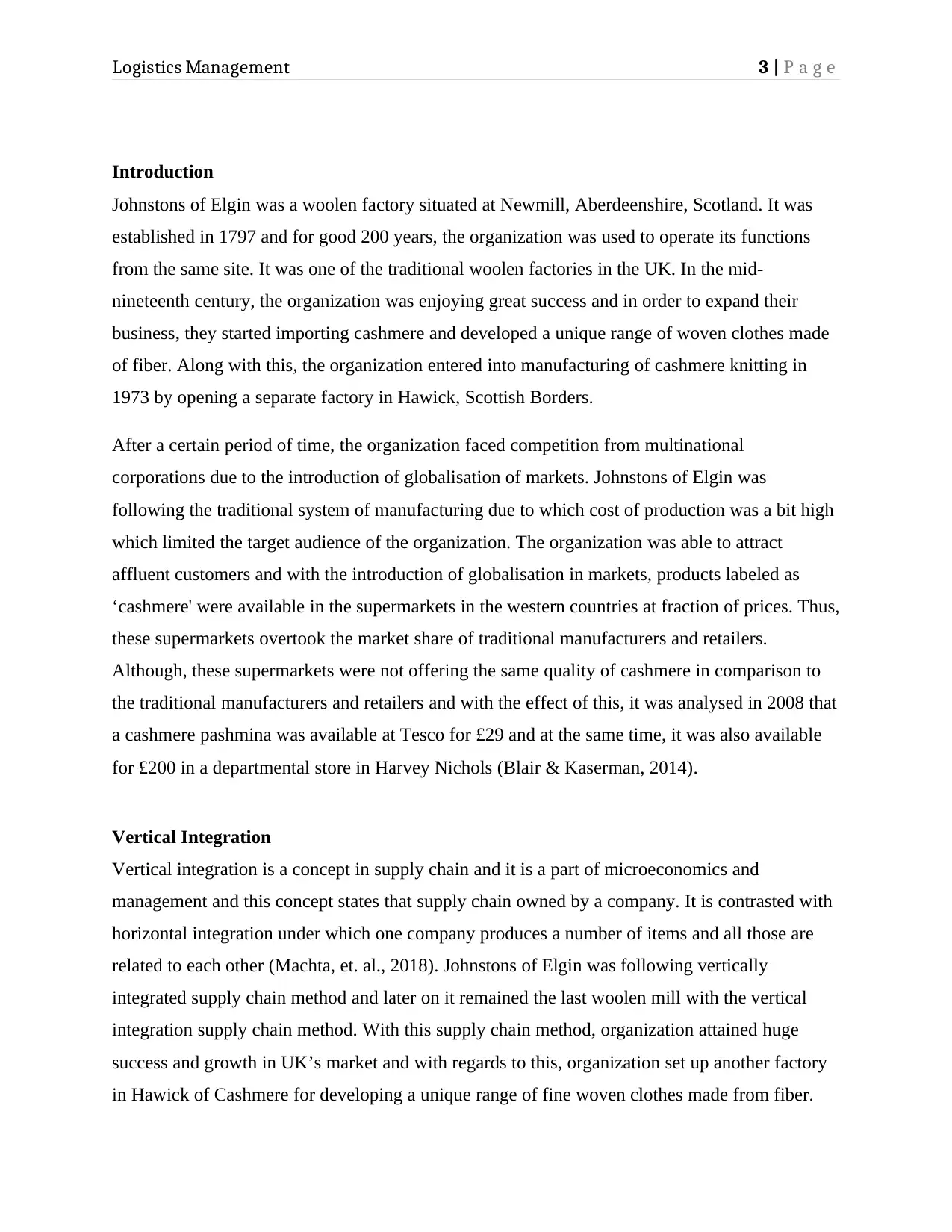
Logistics Management 3 | P a g e
Introduction
Johnstons of Elgin was a woolen factory situated at Newmill, Aberdeenshire, Scotland. It was
established in 1797 and for good 200 years, the organization was used to operate its functions
from the same site. It was one of the traditional woolen factories in the UK. In the mid-
nineteenth century, the organization was enjoying great success and in order to expand their
business, they started importing cashmere and developed a unique range of woven clothes made
of fiber. Along with this, the organization entered into manufacturing of cashmere knitting in
1973 by opening a separate factory in Hawick, Scottish Borders.
After a certain period of time, the organization faced competition from multinational
corporations due to the introduction of globalisation of markets. Johnstons of Elgin was
following the traditional system of manufacturing due to which cost of production was a bit high
which limited the target audience of the organization. The organization was able to attract
affluent customers and with the introduction of globalisation in markets, products labeled as
‘cashmere' were available in the supermarkets in the western countries at fraction of prices. Thus,
these supermarkets overtook the market share of traditional manufacturers and retailers.
Although, these supermarkets were not offering the same quality of cashmere in comparison to
the traditional manufacturers and retailers and with the effect of this, it was analysed in 2008 that
a cashmere pashmina was available at Tesco for £29 and at the same time, it was also available
for £200 in a departmental store in Harvey Nichols (Blair & Kaserman, 2014).
Vertical Integration
Vertical integration is a concept in supply chain and it is a part of microeconomics and
management and this concept states that supply chain owned by a company. It is contrasted with
horizontal integration under which one company produces a number of items and all those are
related to each other (Machta, et. al., 2018). Johnstons of Elgin was following vertically
integrated supply chain method and later on it remained the last woolen mill with the vertical
integration supply chain method. With this supply chain method, organization attained huge
success and growth in UK’s market and with regards to this, organization set up another factory
in Hawick of Cashmere for developing a unique range of fine woven clothes made from fiber.
Introduction
Johnstons of Elgin was a woolen factory situated at Newmill, Aberdeenshire, Scotland. It was
established in 1797 and for good 200 years, the organization was used to operate its functions
from the same site. It was one of the traditional woolen factories in the UK. In the mid-
nineteenth century, the organization was enjoying great success and in order to expand their
business, they started importing cashmere and developed a unique range of woven clothes made
of fiber. Along with this, the organization entered into manufacturing of cashmere knitting in
1973 by opening a separate factory in Hawick, Scottish Borders.
After a certain period of time, the organization faced competition from multinational
corporations due to the introduction of globalisation of markets. Johnstons of Elgin was
following the traditional system of manufacturing due to which cost of production was a bit high
which limited the target audience of the organization. The organization was able to attract
affluent customers and with the introduction of globalisation in markets, products labeled as
‘cashmere' were available in the supermarkets in the western countries at fraction of prices. Thus,
these supermarkets overtook the market share of traditional manufacturers and retailers.
Although, these supermarkets were not offering the same quality of cashmere in comparison to
the traditional manufacturers and retailers and with the effect of this, it was analysed in 2008 that
a cashmere pashmina was available at Tesco for £29 and at the same time, it was also available
for £200 in a departmental store in Harvey Nichols (Blair & Kaserman, 2014).
Vertical Integration
Vertical integration is a concept in supply chain and it is a part of microeconomics and
management and this concept states that supply chain owned by a company. It is contrasted with
horizontal integration under which one company produces a number of items and all those are
related to each other (Machta, et. al., 2018). Johnstons of Elgin was following vertically
integrated supply chain method and later on it remained the last woolen mill with the vertical
integration supply chain method. With this supply chain method, organization attained huge
success and growth in UK’s market and with regards to this, organization set up another factory
in Hawick of Cashmere for developing a unique range of fine woven clothes made from fiber.
Paraphrase This Document
Need a fresh take? Get an instant paraphrase of this document with our AI Paraphraser
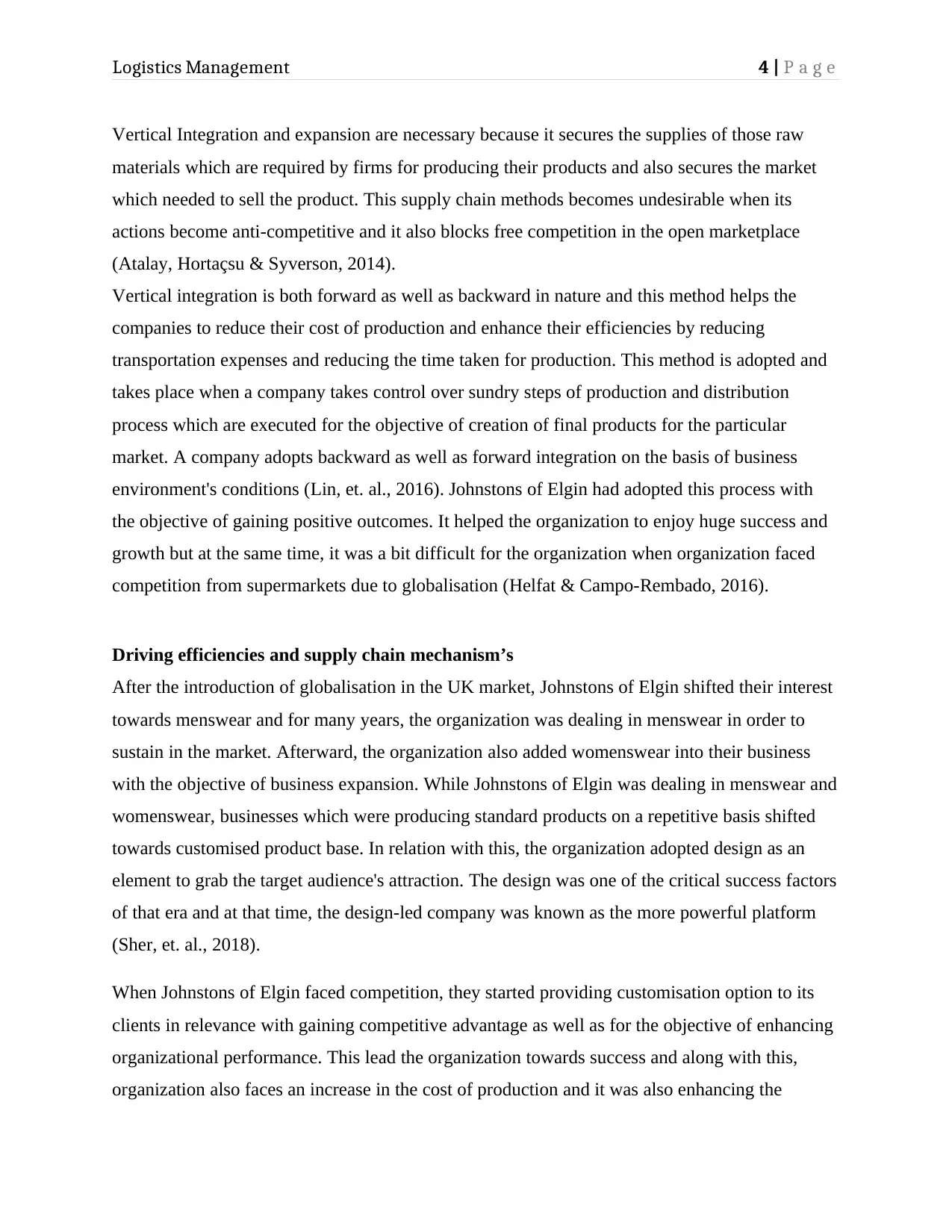
Logistics Management 4 | P a g e
Vertical Integration and expansion are necessary because it secures the supplies of those raw
materials which are required by firms for producing their products and also secures the market
which needed to sell the product. This supply chain methods becomes undesirable when its
actions become anti-competitive and it also blocks free competition in the open marketplace
(Atalay, Hortaçsu & Syverson, 2014).
Vertical integration is both forward as well as backward in nature and this method helps the
companies to reduce their cost of production and enhance their efficiencies by reducing
transportation expenses and reducing the time taken for production. This method is adopted and
takes place when a company takes control over sundry steps of production and distribution
process which are executed for the objective of creation of final products for the particular
market. A company adopts backward as well as forward integration on the basis of business
environment's conditions (Lin, et. al., 2016). Johnstons of Elgin had adopted this process with
the objective of gaining positive outcomes. It helped the organization to enjoy huge success and
growth but at the same time, it was a bit difficult for the organization when organization faced
competition from supermarkets due to globalisation (Helfat & Campo-Rembado, 2016).
Driving efficiencies and supply chain mechanism’s
After the introduction of globalisation in the UK market, Johnstons of Elgin shifted their interest
towards menswear and for many years, the organization was dealing in menswear in order to
sustain in the market. Afterward, the organization also added womenswear into their business
with the objective of business expansion. While Johnstons of Elgin was dealing in menswear and
womenswear, businesses which were producing standard products on a repetitive basis shifted
towards customised product base. In relation with this, the organization adopted design as an
element to grab the target audience's attraction. The design was one of the critical success factors
of that era and at that time, the design-led company was known as the more powerful platform
(Sher, et. al., 2018).
When Johnstons of Elgin faced competition, they started providing customisation option to its
clients in relevance with gaining competitive advantage as well as for the objective of enhancing
organizational performance. This lead the organization towards success and along with this,
organization also faces an increase in the cost of production and it was also enhancing the
Vertical Integration and expansion are necessary because it secures the supplies of those raw
materials which are required by firms for producing their products and also secures the market
which needed to sell the product. This supply chain methods becomes undesirable when its
actions become anti-competitive and it also blocks free competition in the open marketplace
(Atalay, Hortaçsu & Syverson, 2014).
Vertical integration is both forward as well as backward in nature and this method helps the
companies to reduce their cost of production and enhance their efficiencies by reducing
transportation expenses and reducing the time taken for production. This method is adopted and
takes place when a company takes control over sundry steps of production and distribution
process which are executed for the objective of creation of final products for the particular
market. A company adopts backward as well as forward integration on the basis of business
environment's conditions (Lin, et. al., 2016). Johnstons of Elgin had adopted this process with
the objective of gaining positive outcomes. It helped the organization to enjoy huge success and
growth but at the same time, it was a bit difficult for the organization when organization faced
competition from supermarkets due to globalisation (Helfat & Campo-Rembado, 2016).
Driving efficiencies and supply chain mechanism’s
After the introduction of globalisation in the UK market, Johnstons of Elgin shifted their interest
towards menswear and for many years, the organization was dealing in menswear in order to
sustain in the market. Afterward, the organization also added womenswear into their business
with the objective of business expansion. While Johnstons of Elgin was dealing in menswear and
womenswear, businesses which were producing standard products on a repetitive basis shifted
towards customised product base. In relation with this, the organization adopted design as an
element to grab the target audience's attraction. The design was one of the critical success factors
of that era and at that time, the design-led company was known as the more powerful platform
(Sher, et. al., 2018).
When Johnstons of Elgin faced competition, they started providing customisation option to its
clients in relevance with gaining competitive advantage as well as for the objective of enhancing
organizational performance. This lead the organization towards success and along with this,
organization also faces an increase in the cost of production and it was also enhancing the
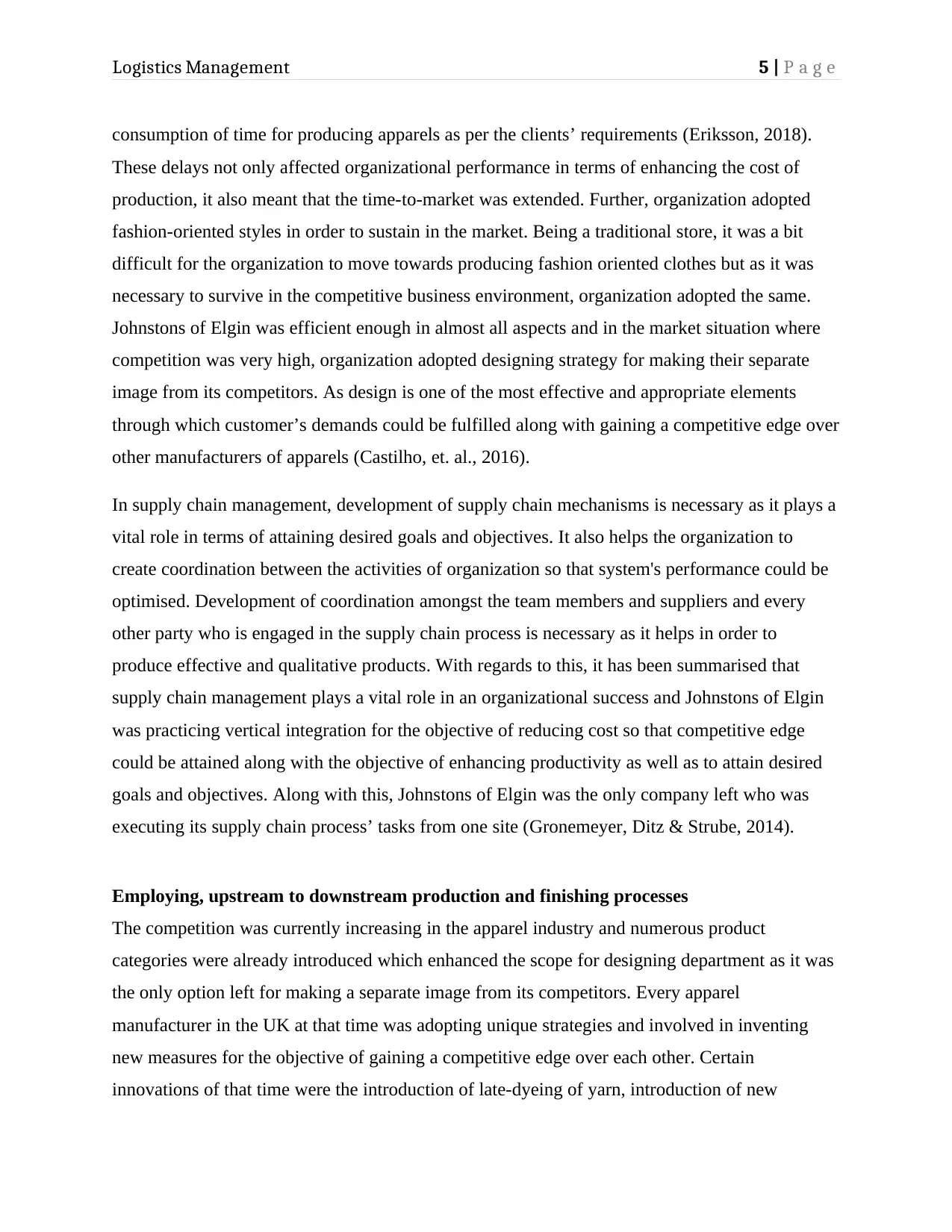
Logistics Management 5 | P a g e
consumption of time for producing apparels as per the clients’ requirements (Eriksson, 2018).
These delays not only affected organizational performance in terms of enhancing the cost of
production, it also meant that the time-to-market was extended. Further, organization adopted
fashion-oriented styles in order to sustain in the market. Being a traditional store, it was a bit
difficult for the organization to move towards producing fashion oriented clothes but as it was
necessary to survive in the competitive business environment, organization adopted the same.
Johnstons of Elgin was efficient enough in almost all aspects and in the market situation where
competition was very high, organization adopted designing strategy for making their separate
image from its competitors. As design is one of the most effective and appropriate elements
through which customer’s demands could be fulfilled along with gaining a competitive edge over
other manufacturers of apparels (Castilho, et. al., 2016).
In supply chain management, development of supply chain mechanisms is necessary as it plays a
vital role in terms of attaining desired goals and objectives. It also helps the organization to
create coordination between the activities of organization so that system's performance could be
optimised. Development of coordination amongst the team members and suppliers and every
other party who is engaged in the supply chain process is necessary as it helps in order to
produce effective and qualitative products. With regards to this, it has been summarised that
supply chain management plays a vital role in an organizational success and Johnstons of Elgin
was practicing vertical integration for the objective of reducing cost so that competitive edge
could be attained along with the objective of enhancing productivity as well as to attain desired
goals and objectives. Along with this, Johnstons of Elgin was the only company left who was
executing its supply chain process’ tasks from one site (Gronemeyer, Ditz & Strube, 2014).
Employing, upstream to downstream production and finishing processes
The competition was currently increasing in the apparel industry and numerous product
categories were already introduced which enhanced the scope for designing department as it was
the only option left for making a separate image from its competitors. Every apparel
manufacturer in the UK at that time was adopting unique strategies and involved in inventing
new measures for the objective of gaining a competitive edge over each other. Certain
innovations of that time were the introduction of late-dyeing of yarn, introduction of new
consumption of time for producing apparels as per the clients’ requirements (Eriksson, 2018).
These delays not only affected organizational performance in terms of enhancing the cost of
production, it also meant that the time-to-market was extended. Further, organization adopted
fashion-oriented styles in order to sustain in the market. Being a traditional store, it was a bit
difficult for the organization to move towards producing fashion oriented clothes but as it was
necessary to survive in the competitive business environment, organization adopted the same.
Johnstons of Elgin was efficient enough in almost all aspects and in the market situation where
competition was very high, organization adopted designing strategy for making their separate
image from its competitors. As design is one of the most effective and appropriate elements
through which customer’s demands could be fulfilled along with gaining a competitive edge over
other manufacturers of apparels (Castilho, et. al., 2016).
In supply chain management, development of supply chain mechanisms is necessary as it plays a
vital role in terms of attaining desired goals and objectives. It also helps the organization to
create coordination between the activities of organization so that system's performance could be
optimised. Development of coordination amongst the team members and suppliers and every
other party who is engaged in the supply chain process is necessary as it helps in order to
produce effective and qualitative products. With regards to this, it has been summarised that
supply chain management plays a vital role in an organizational success and Johnstons of Elgin
was practicing vertical integration for the objective of reducing cost so that competitive edge
could be attained along with the objective of enhancing productivity as well as to attain desired
goals and objectives. Along with this, Johnstons of Elgin was the only company left who was
executing its supply chain process’ tasks from one site (Gronemeyer, Ditz & Strube, 2014).
Employing, upstream to downstream production and finishing processes
The competition was currently increasing in the apparel industry and numerous product
categories were already introduced which enhanced the scope for designing department as it was
the only option left for making a separate image from its competitors. Every apparel
manufacturer in the UK at that time was adopting unique strategies and involved in inventing
new measures for the objective of gaining a competitive edge over each other. Certain
innovations of that time were the introduction of late-dyeing of yarn, introduction of new
⊘ This is a preview!⊘
Do you want full access?
Subscribe today to unlock all pages.

Trusted by 1+ million students worldwide
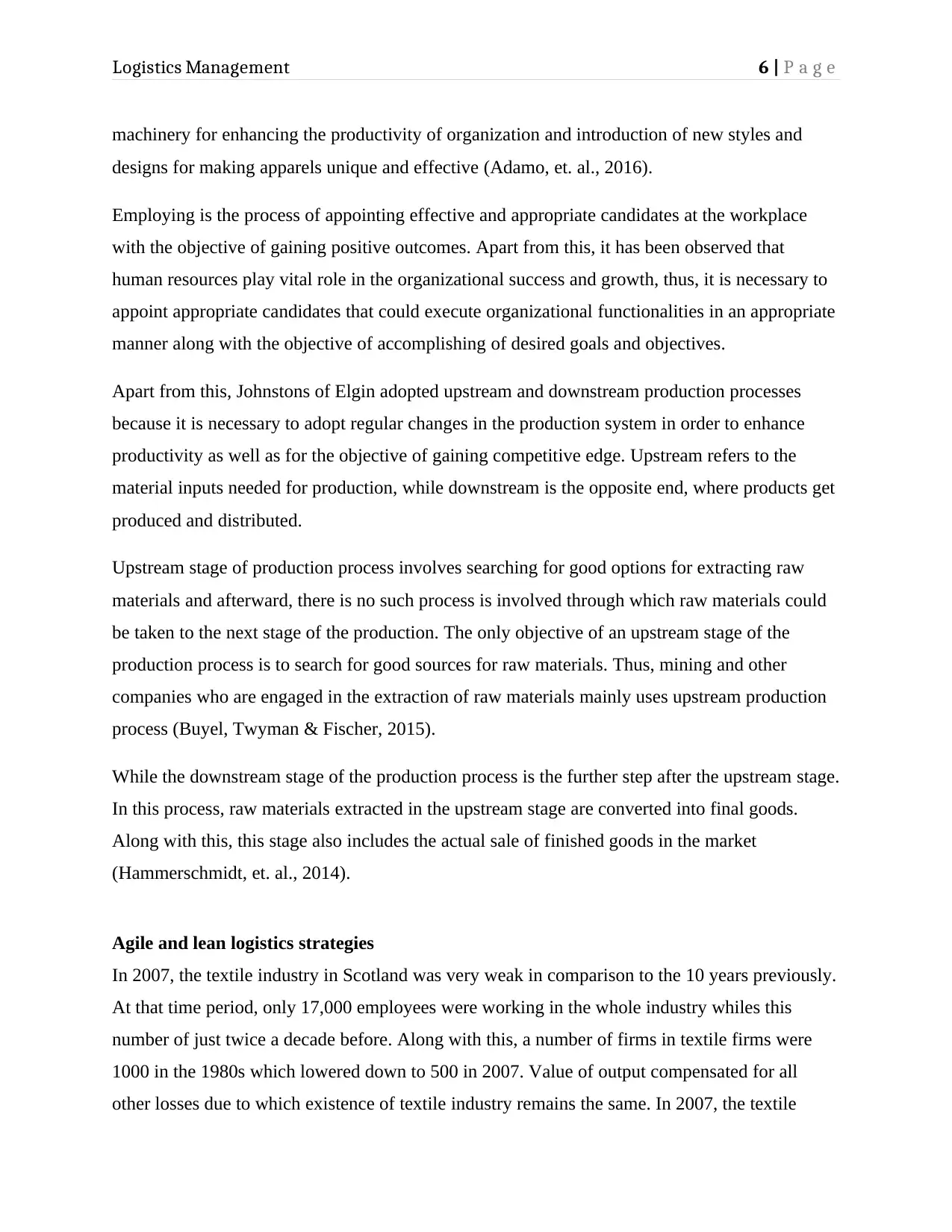
Logistics Management 6 | P a g e
machinery for enhancing the productivity of organization and introduction of new styles and
designs for making apparels unique and effective (Adamo, et. al., 2016).
Employing is the process of appointing effective and appropriate candidates at the workplace
with the objective of gaining positive outcomes. Apart from this, it has been observed that
human resources play vital role in the organizational success and growth, thus, it is necessary to
appoint appropriate candidates that could execute organizational functionalities in an appropriate
manner along with the objective of accomplishing of desired goals and objectives.
Apart from this, Johnstons of Elgin adopted upstream and downstream production processes
because it is necessary to adopt regular changes in the production system in order to enhance
productivity as well as for the objective of gaining competitive edge. Upstream refers to the
material inputs needed for production, while downstream is the opposite end, where products get
produced and distributed.
Upstream stage of production process involves searching for good options for extracting raw
materials and afterward, there is no such process is involved through which raw materials could
be taken to the next stage of the production. The only objective of an upstream stage of the
production process is to search for good sources for raw materials. Thus, mining and other
companies who are engaged in the extraction of raw materials mainly uses upstream production
process (Buyel, Twyman & Fischer, 2015).
While the downstream stage of the production process is the further step after the upstream stage.
In this process, raw materials extracted in the upstream stage are converted into final goods.
Along with this, this stage also includes the actual sale of finished goods in the market
(Hammerschmidt, et. al., 2014).
Agile and lean logistics strategies
In 2007, the textile industry in Scotland was very weak in comparison to the 10 years previously.
At that time period, only 17,000 employees were working in the whole industry whiles this
number of just twice a decade before. Along with this, a number of firms in textile firms were
1000 in the 1980s which lowered down to 500 in 2007. Value of output compensated for all
other losses due to which existence of textile industry remains the same. In 2007, the textile
machinery for enhancing the productivity of organization and introduction of new styles and
designs for making apparels unique and effective (Adamo, et. al., 2016).
Employing is the process of appointing effective and appropriate candidates at the workplace
with the objective of gaining positive outcomes. Apart from this, it has been observed that
human resources play vital role in the organizational success and growth, thus, it is necessary to
appoint appropriate candidates that could execute organizational functionalities in an appropriate
manner along with the objective of accomplishing of desired goals and objectives.
Apart from this, Johnstons of Elgin adopted upstream and downstream production processes
because it is necessary to adopt regular changes in the production system in order to enhance
productivity as well as for the objective of gaining competitive edge. Upstream refers to the
material inputs needed for production, while downstream is the opposite end, where products get
produced and distributed.
Upstream stage of production process involves searching for good options for extracting raw
materials and afterward, there is no such process is involved through which raw materials could
be taken to the next stage of the production. The only objective of an upstream stage of the
production process is to search for good sources for raw materials. Thus, mining and other
companies who are engaged in the extraction of raw materials mainly uses upstream production
process (Buyel, Twyman & Fischer, 2015).
While the downstream stage of the production process is the further step after the upstream stage.
In this process, raw materials extracted in the upstream stage are converted into final goods.
Along with this, this stage also includes the actual sale of finished goods in the market
(Hammerschmidt, et. al., 2014).
Agile and lean logistics strategies
In 2007, the textile industry in Scotland was very weak in comparison to the 10 years previously.
At that time period, only 17,000 employees were working in the whole industry whiles this
number of just twice a decade before. Along with this, a number of firms in textile firms were
1000 in the 1980s which lowered down to 500 in 2007. Value of output compensated for all
other losses due to which existence of textile industry remains the same. In 2007, the textile
Paraphrase This Document
Need a fresh take? Get an instant paraphrase of this document with our AI Paraphraser
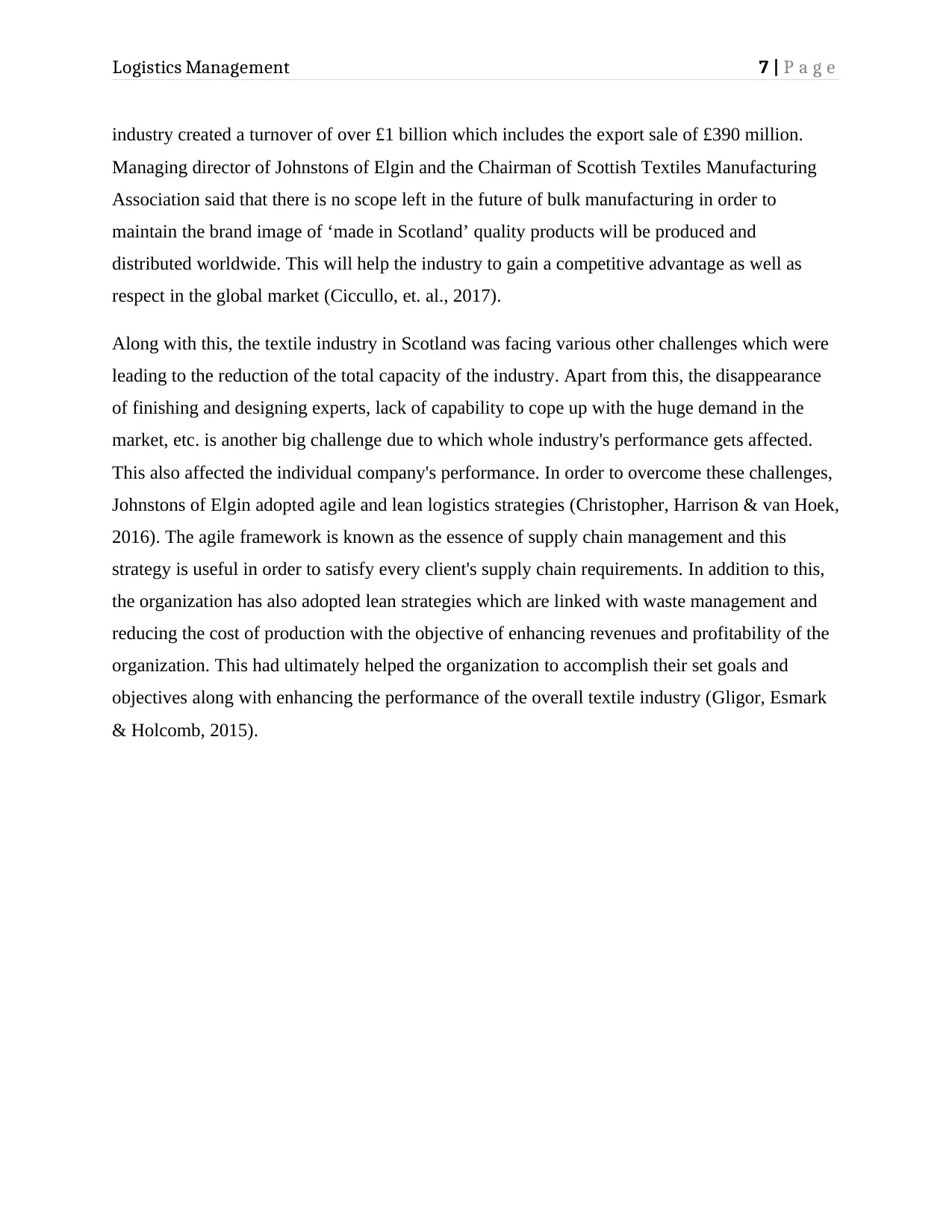
Logistics Management 7 | P a g e
industry created a turnover of over £1 billion which includes the export sale of £390 million.
Managing director of Johnstons of Elgin and the Chairman of Scottish Textiles Manufacturing
Association said that there is no scope left in the future of bulk manufacturing in order to
maintain the brand image of ‘made in Scotland’ quality products will be produced and
distributed worldwide. This will help the industry to gain a competitive advantage as well as
respect in the global market (Ciccullo, et. al., 2017).
Along with this, the textile industry in Scotland was facing various other challenges which were
leading to the reduction of the total capacity of the industry. Apart from this, the disappearance
of finishing and designing experts, lack of capability to cope up with the huge demand in the
market, etc. is another big challenge due to which whole industry's performance gets affected.
This also affected the individual company's performance. In order to overcome these challenges,
Johnstons of Elgin adopted agile and lean logistics strategies (Christopher, Harrison & van Hoek,
2016). The agile framework is known as the essence of supply chain management and this
strategy is useful in order to satisfy every client's supply chain requirements. In addition to this,
the organization has also adopted lean strategies which are linked with waste management and
reducing the cost of production with the objective of enhancing revenues and profitability of the
organization. This had ultimately helped the organization to accomplish their set goals and
objectives along with enhancing the performance of the overall textile industry (Gligor, Esmark
& Holcomb, 2015).
industry created a turnover of over £1 billion which includes the export sale of £390 million.
Managing director of Johnstons of Elgin and the Chairman of Scottish Textiles Manufacturing
Association said that there is no scope left in the future of bulk manufacturing in order to
maintain the brand image of ‘made in Scotland’ quality products will be produced and
distributed worldwide. This will help the industry to gain a competitive advantage as well as
respect in the global market (Ciccullo, et. al., 2017).
Along with this, the textile industry in Scotland was facing various other challenges which were
leading to the reduction of the total capacity of the industry. Apart from this, the disappearance
of finishing and designing experts, lack of capability to cope up with the huge demand in the
market, etc. is another big challenge due to which whole industry's performance gets affected.
This also affected the individual company's performance. In order to overcome these challenges,
Johnstons of Elgin adopted agile and lean logistics strategies (Christopher, Harrison & van Hoek,
2016). The agile framework is known as the essence of supply chain management and this
strategy is useful in order to satisfy every client's supply chain requirements. In addition to this,
the organization has also adopted lean strategies which are linked with waste management and
reducing the cost of production with the objective of enhancing revenues and profitability of the
organization. This had ultimately helped the organization to accomplish their set goals and
objectives along with enhancing the performance of the overall textile industry (Gligor, Esmark
& Holcomb, 2015).
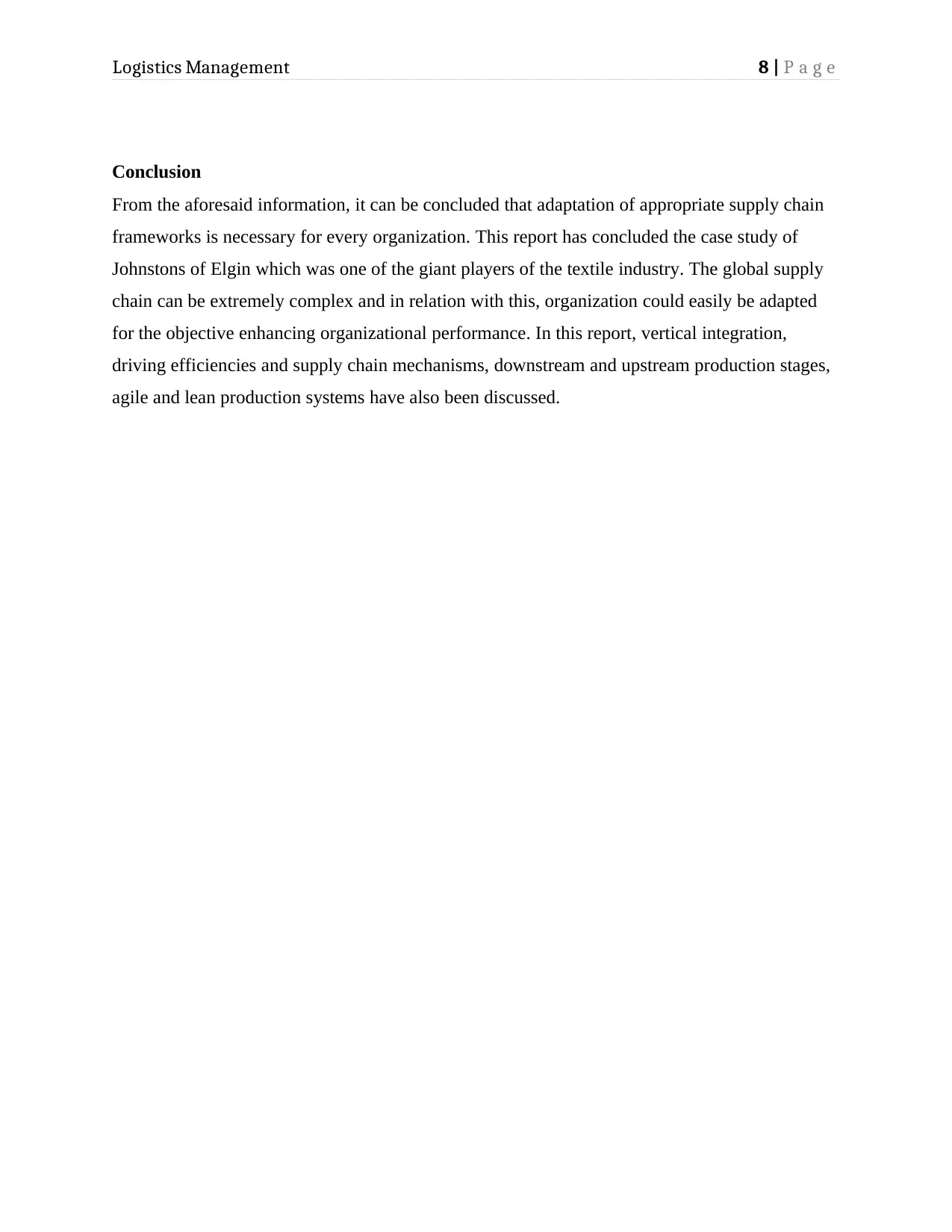
Logistics Management 8 | P a g e
Conclusion
From the aforesaid information, it can be concluded that adaptation of appropriate supply chain
frameworks is necessary for every organization. This report has concluded the case study of
Johnstons of Elgin which was one of the giant players of the textile industry. The global supply
chain can be extremely complex and in relation with this, organization could easily be adapted
for the objective enhancing organizational performance. In this report, vertical integration,
driving efficiencies and supply chain mechanisms, downstream and upstream production stages,
agile and lean production systems have also been discussed.
Conclusion
From the aforesaid information, it can be concluded that adaptation of appropriate supply chain
frameworks is necessary for every organization. This report has concluded the case study of
Johnstons of Elgin which was one of the giant players of the textile industry. The global supply
chain can be extremely complex and in relation with this, organization could easily be adapted
for the objective enhancing organizational performance. In this report, vertical integration,
driving efficiencies and supply chain mechanisms, downstream and upstream production stages,
agile and lean production systems have also been discussed.
⊘ This is a preview!⊘
Do you want full access?
Subscribe today to unlock all pages.

Trusted by 1+ million students worldwide
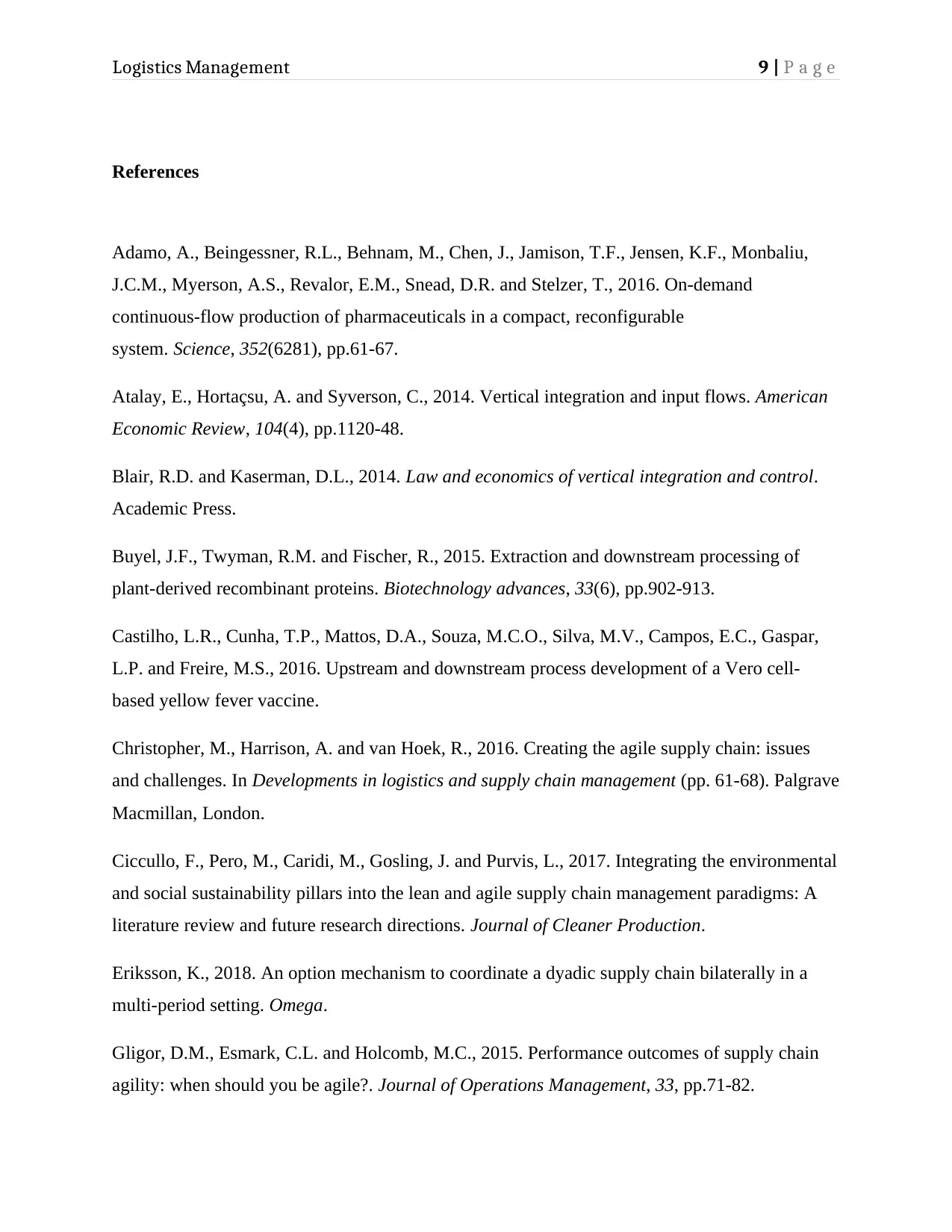
Logistics Management 9 | P a g e
References
Adamo, A., Beingessner, R.L., Behnam, M., Chen, J., Jamison, T.F., Jensen, K.F., Monbaliu,
J.C.M., Myerson, A.S., Revalor, E.M., Snead, D.R. and Stelzer, T., 2016. On-demand
continuous-flow production of pharmaceuticals in a compact, reconfigurable
system. Science, 352(6281), pp.61-67.
Atalay, E., Hortaçsu, A. and Syverson, C., 2014. Vertical integration and input flows. American
Economic Review, 104(4), pp.1120-48.
Blair, R.D. and Kaserman, D.L., 2014. Law and economics of vertical integration and control.
Academic Press.
Buyel, J.F., Twyman, R.M. and Fischer, R., 2015. Extraction and downstream processing of
plant-derived recombinant proteins. Biotechnology advances, 33(6), pp.902-913.
Castilho, L.R., Cunha, T.P., Mattos, D.A., Souza, M.C.O., Silva, M.V., Campos, E.C., Gaspar,
L.P. and Freire, M.S., 2016. Upstream and downstream process development of a Vero cell-
based yellow fever vaccine.
Christopher, M., Harrison, A. and van Hoek, R., 2016. Creating the agile supply chain: issues
and challenges. In Developments in logistics and supply chain management (pp. 61-68). Palgrave
Macmillan, London.
Ciccullo, F., Pero, M., Caridi, M., Gosling, J. and Purvis, L., 2017. Integrating the environmental
and social sustainability pillars into the lean and agile supply chain management paradigms: A
literature review and future research directions. Journal of Cleaner Production.
Eriksson, K., 2018. An option mechanism to coordinate a dyadic supply chain bilaterally in a
multi-period setting. Omega.
Gligor, D.M., Esmark, C.L. and Holcomb, M.C., 2015. Performance outcomes of supply chain
agility: when should you be agile?. Journal of Operations Management, 33, pp.71-82.
References
Adamo, A., Beingessner, R.L., Behnam, M., Chen, J., Jamison, T.F., Jensen, K.F., Monbaliu,
J.C.M., Myerson, A.S., Revalor, E.M., Snead, D.R. and Stelzer, T., 2016. On-demand
continuous-flow production of pharmaceuticals in a compact, reconfigurable
system. Science, 352(6281), pp.61-67.
Atalay, E., Hortaçsu, A. and Syverson, C., 2014. Vertical integration and input flows. American
Economic Review, 104(4), pp.1120-48.
Blair, R.D. and Kaserman, D.L., 2014. Law and economics of vertical integration and control.
Academic Press.
Buyel, J.F., Twyman, R.M. and Fischer, R., 2015. Extraction and downstream processing of
plant-derived recombinant proteins. Biotechnology advances, 33(6), pp.902-913.
Castilho, L.R., Cunha, T.P., Mattos, D.A., Souza, M.C.O., Silva, M.V., Campos, E.C., Gaspar,
L.P. and Freire, M.S., 2016. Upstream and downstream process development of a Vero cell-
based yellow fever vaccine.
Christopher, M., Harrison, A. and van Hoek, R., 2016. Creating the agile supply chain: issues
and challenges. In Developments in logistics and supply chain management (pp. 61-68). Palgrave
Macmillan, London.
Ciccullo, F., Pero, M., Caridi, M., Gosling, J. and Purvis, L., 2017. Integrating the environmental
and social sustainability pillars into the lean and agile supply chain management paradigms: A
literature review and future research directions. Journal of Cleaner Production.
Eriksson, K., 2018. An option mechanism to coordinate a dyadic supply chain bilaterally in a
multi-period setting. Omega.
Gligor, D.M., Esmark, C.L. and Holcomb, M.C., 2015. Performance outcomes of supply chain
agility: when should you be agile?. Journal of Operations Management, 33, pp.71-82.
Paraphrase This Document
Need a fresh take? Get an instant paraphrase of this document with our AI Paraphraser
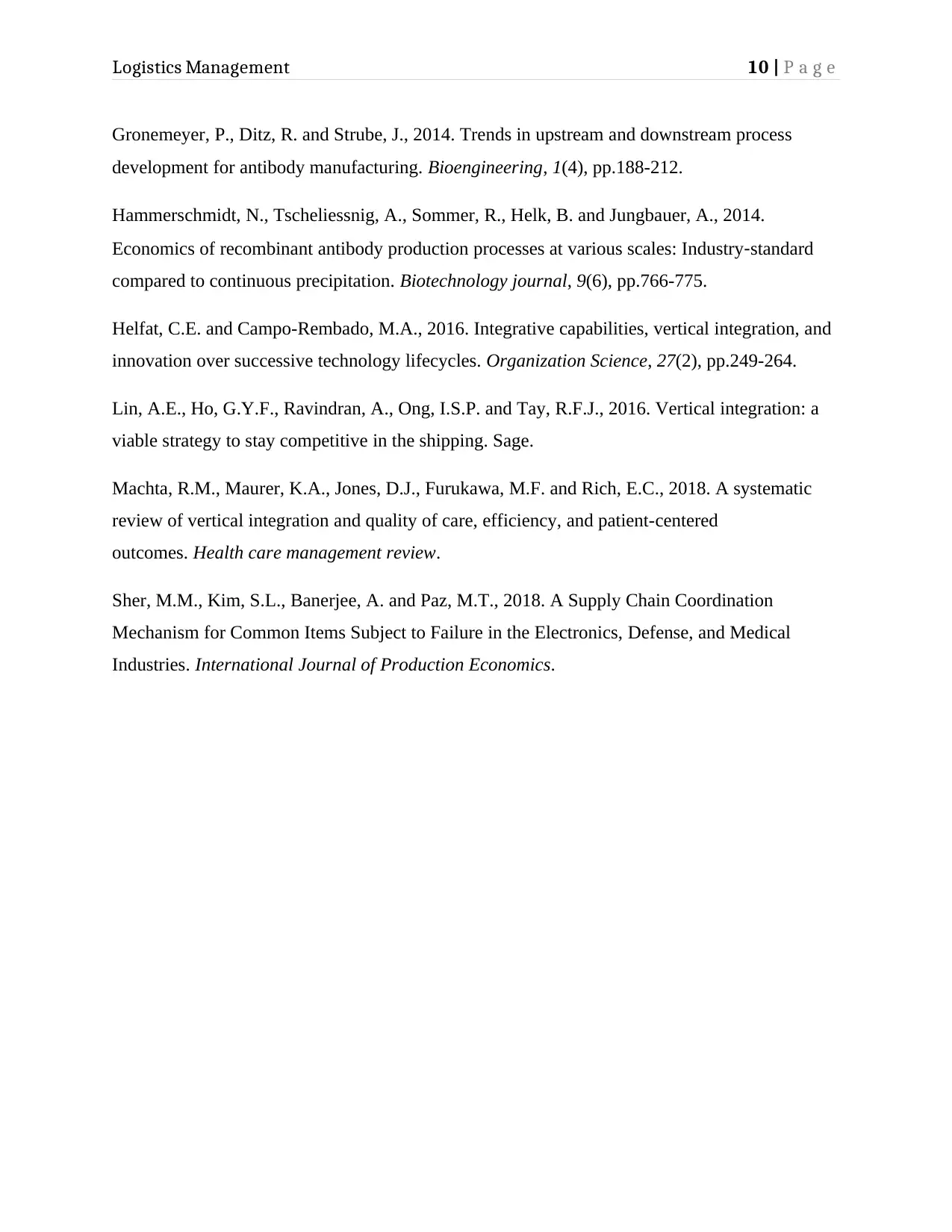
Logistics Management 10 | P a g e
Gronemeyer, P., Ditz, R. and Strube, J., 2014. Trends in upstream and downstream process
development for antibody manufacturing. Bioengineering, 1(4), pp.188-212.
Hammerschmidt, N., Tscheliessnig, A., Sommer, R., Helk, B. and Jungbauer, A., 2014.
Economics of recombinant antibody production processes at various scales: Industry‐standard
compared to continuous precipitation. Biotechnology journal, 9(6), pp.766-775.
Helfat, C.E. and Campo-Rembado, M.A., 2016. Integrative capabilities, vertical integration, and
innovation over successive technology lifecycles. Organization Science, 27(2), pp.249-264.
Lin, A.E., Ho, G.Y.F., Ravindran, A., Ong, I.S.P. and Tay, R.F.J., 2016. Vertical integration: a
viable strategy to stay competitive in the shipping. Sage.
Machta, R.M., Maurer, K.A., Jones, D.J., Furukawa, M.F. and Rich, E.C., 2018. A systematic
review of vertical integration and quality of care, efficiency, and patient-centered
outcomes. Health care management review.
Sher, M.M., Kim, S.L., Banerjee, A. and Paz, M.T., 2018. A Supply Chain Coordination
Mechanism for Common Items Subject to Failure in the Electronics, Defense, and Medical
Industries. International Journal of Production Economics.
Gronemeyer, P., Ditz, R. and Strube, J., 2014. Trends in upstream and downstream process
development for antibody manufacturing. Bioengineering, 1(4), pp.188-212.
Hammerschmidt, N., Tscheliessnig, A., Sommer, R., Helk, B. and Jungbauer, A., 2014.
Economics of recombinant antibody production processes at various scales: Industry‐standard
compared to continuous precipitation. Biotechnology journal, 9(6), pp.766-775.
Helfat, C.E. and Campo-Rembado, M.A., 2016. Integrative capabilities, vertical integration, and
innovation over successive technology lifecycles. Organization Science, 27(2), pp.249-264.
Lin, A.E., Ho, G.Y.F., Ravindran, A., Ong, I.S.P. and Tay, R.F.J., 2016. Vertical integration: a
viable strategy to stay competitive in the shipping. Sage.
Machta, R.M., Maurer, K.A., Jones, D.J., Furukawa, M.F. and Rich, E.C., 2018. A systematic
review of vertical integration and quality of care, efficiency, and patient-centered
outcomes. Health care management review.
Sher, M.M., Kim, S.L., Banerjee, A. and Paz, M.T., 2018. A Supply Chain Coordination
Mechanism for Common Items Subject to Failure in the Electronics, Defense, and Medical
Industries. International Journal of Production Economics.
1 out of 11
Related Documents
Your All-in-One AI-Powered Toolkit for Academic Success.
+13062052269
info@desklib.com
Available 24*7 on WhatsApp / Email
![[object Object]](/_next/static/media/star-bottom.7253800d.svg)
Unlock your academic potential
Copyright © 2020–2025 A2Z Services. All Rights Reserved. Developed and managed by ZUCOL.




